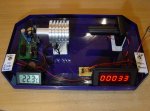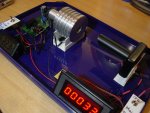about efficiency and imperfections:
until now we were only speaking about imperfections on the facet, which increase and accumulate and all. shouldnt we be able to see either more scattered, diffuse light from the die, or dark areas on the facet, when there are such imperfections? speaking about differences in the 10% range, this wouldnt be much to detect, of course. but maybe it would yield some interesting results to look at a de-canned diode for scatter with a phototransistor or something, and have a look at the facet (off axis angle!) under a microscope with low optical output? a nightmare, thinking about the eye-risk!
if that all doesnt lead to anything, the impurities have to be in the cavity.. but then low-efficiency diodes shouldnt die earlier, when at the same thermal stress?
manuel
You reminded me of something very interesting with the above..
But first let me explain something.. These "imperfections" are NOT big enough to make themselves noticable in this manner. IF they were, the diode would not survive a single powerup.
The die has to be near perfect for the diode to even work.
The other thing is, that a LOT of this is just guessing. I don't really know where efficiency differences come from, i'm not a laser scientist, i am an amateur when it comes to this, and my assumptions are based on the experiences i gathered making over a hundred lasers and killing a bunch of diodes..
I know that high powers are easier to reach with higher efficiency diodes, and i know that some very low efficiency diodes can't even survive the currents where most others "thrive"...
BUT! This experience mostly comes from GGWs, and we already decided it's most likelly the early sleds contained prototypes, so it's VERY likelly that most of the low efficiency GGWs that gave me the bad experiences were prototype diodes never really meant to work in a 6x drive!
However you mentioned visible differences in output...
There are two things i would like to mention about this..
There is one thing i haven't mentioned yet.. While testing these 8x's, i noticed where the "splatter" comes from for the first time!
With every single diode i went looking for Ith..
Because of this i spent a lot of time at currents below lasing threshold, trying to find the spot where the first signs of lasing become apparent...
Well, i usually define Ith as the current where the power on my meter minus spontaneous emissions (i zero-in the LPM just under Ith, so spontaneous emissions are not included in the readings) measures 1mW...
The actual lasing threshold is actually a little lower, but for our purposes this is good enough IMO..
But the thing i wanted to mention was this. The "splatter" was evident long before any lasing occured! It had the exact same shape and form as the splatter we notice at higher powers, only that it was easier to see, not having been blinded by the spot!
So to me it looked like the splatter is the result of the ENTIRE DIE SURFACE producing some minimum light output in the form of spontaneous emissions.
I mean, the "splatter" as we call it is rectangular. And then, as i would raise the current, at the middle of one of the longer sides of this rectangle, the spot would appear and start becoming brighter and brighter - that spot is the point source of the stimulated emissions..
Because of this i got the feeling, that the entire surface is producing some light, and i also noticed that these spontaneous emissions forming the "splatter" become stronger with current, however not at the same rate as the spot becomes more powerful of course, so the spot drowns out a lot of the detail..
This is why i only really noticed it when i spent a lot of time under the lasing threshold, looking for Ith.
Another thing i'd like to mention is something else - what i called spontaneous emissions before this...
Last year, at some time i almost went blind on one eye, and had to stop using contacts for a while, and use glasses instead.
Unfortunatelly, my glasses block almost all 405nm light, and i really hate them for this..
But while playing with lasers, i noticed something interesting around the spot of PHRs with regular acrylic lenses.. I would suddenly see something i never noticed before.
There were usually two yellow-ish blobs around the slow axis of the spot if i recall correctly. One would be bigger, the other smaller.
The intensity of these two blobs would vary from diode to diode....
Later, when my eye healed, and i started using contacts again, i didn't see this, but as i was aware of it, i went looking for it, and for a while i was recording it with each diode i used - to see if it would matter with how long they survive...
That was when i started sorting diodes by wavelength, using relative comparisons through a special filter, and i would also make a note of this "yellow halo"...
With some diodes it was completelly absent, while others had it MUCH more noticable! So for a while i was making notes on the intensity of this yellow halo, to see if spontaneous emissions like that - guesstimated by several to be the result of impurities - would matter, when it comes to diode life...
Unfortunatelly (or luckily, since it was present almost everywhere?) i couldn't find any patternns or connections between "yellow-halo" intensity and diode failure rate...
But this was in the time before i knew of the "splatter", since i didn't have good working glass lenses yet.
With these 8x's it was the first time i was testing a LARGE batch of diodes using the 405-G-1 lens....
And at around diode five or six it occured to me to test wavelength as well.. Suddenly i would notice the yellow halo again. Since i tried comparing the wavelengths to my wavelength reference lasers, and those use AixiZ lenses, the yelow halo of 8x's seemed HUGE in comparison! But it was only because of the short FL of the lens used in them...
This was also the first time i noticed the "yellow halo" AND the "splatter" at the same time.
The yellow halo is only visible after the filter, since the 405nm (and blue-ish colors) are blocked with a yellow filter.
But having spent quite some time below Ith i was able to observe both at once projected on a sheet of paper....
Since there are a few diodes where i didn't test the wavelength yet, i should repeat these tests, and try to capture a good splatter picture without the interference of the spot, as well as the halo i am talking about.
As i already said, i don't know if it even means anything or not, but it did show big variations between individual diodes, just like with GGWs.. But at the same time it is not related to their wavelengths or anything else as far as i can tell...







